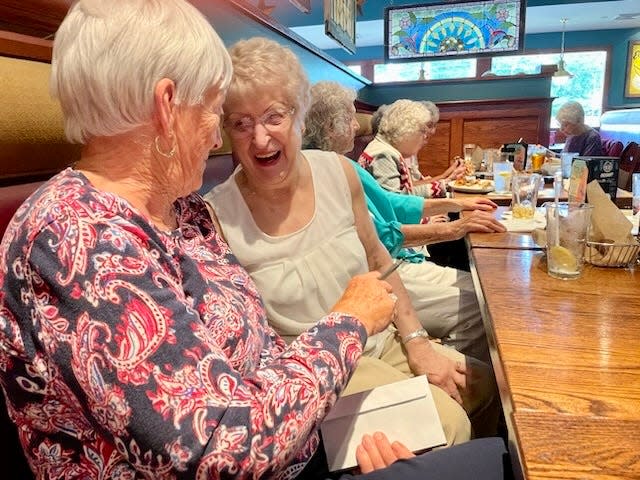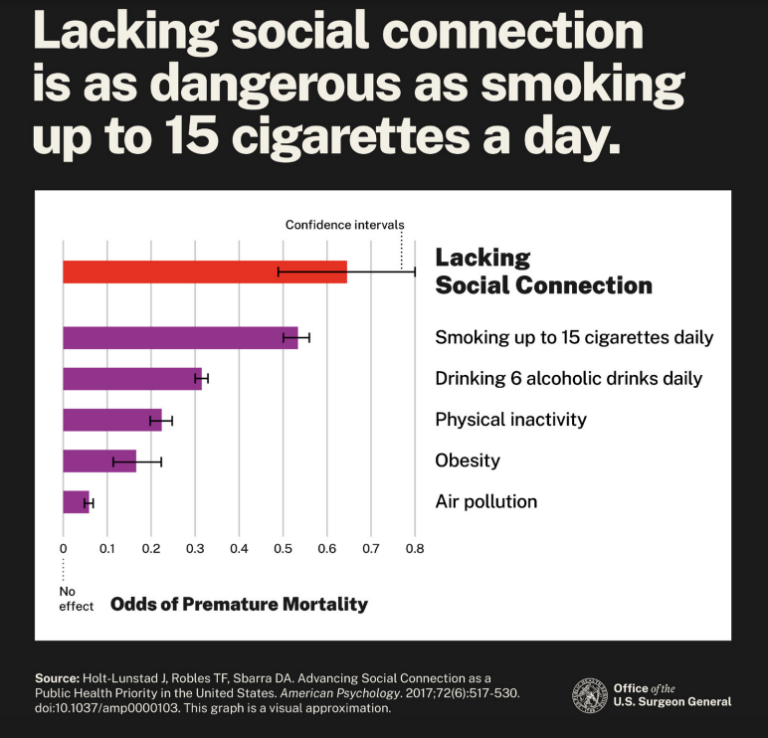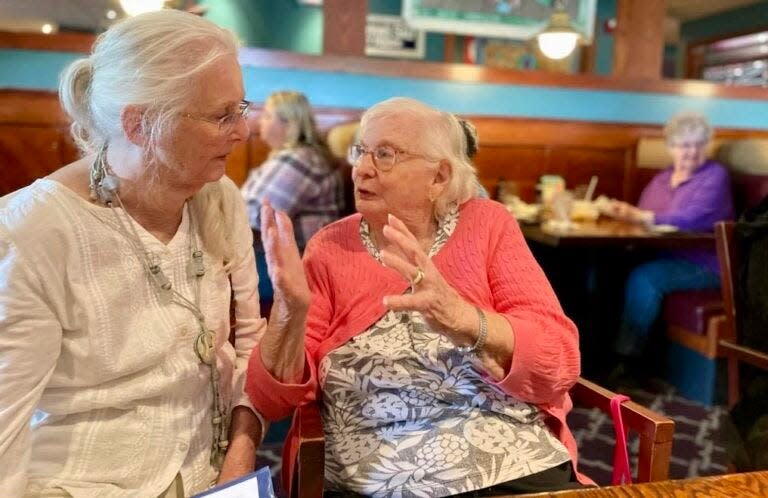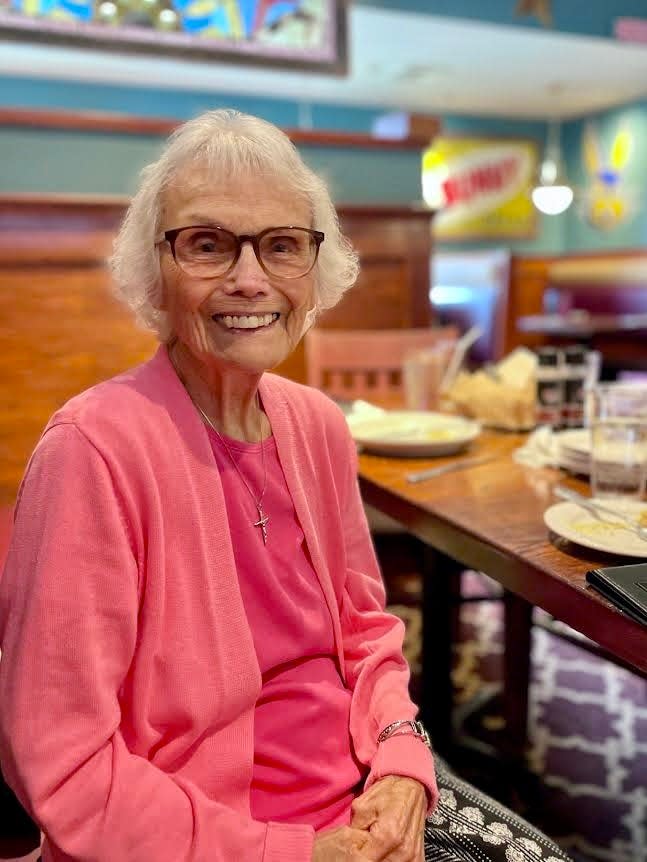What connects smoking, obesity, and social isolation? Each can kill you.

For nearly 30 years, a group of women from Laconia High School’s class of 1952 has met monthly for dinner or lunch. They’ve seen one another through the deaths of husbands, swapped pictures of grandchildren, and reminisced about raiding their mother’s cabinets in the 1940s, in search of metal and tin to support the war effort.
“It’s such a blessing to see everyone and share our senior years together,” Lorraine Benoit, of Laconia, told me during a lunch in 1990. The women had grown so close, she said then, that they felt like sisters.
Tuesday, Benoit and a dozen classmates, now in their late 80s, met for lunch at T-BONES in Laconia. For the last time.
Over grilled cheese sandwiches and BLTs, the women said ending their tradition was a choice of necessity, not desire. While some are still mowing their lawns, delivering a daily newspaper to neighbors, or volunteering with their church, others struggle to get out because they have no transportation or mobility challenges.
“So many of us are not driving,” said Dorothy Duffy, of Laconia. “The biggest hardship for elderly people is the loss of their car and reliable transportation. They go from independent to totally dependent.”
It’s precisely that transition that worries aging experts and health care providers.
“There’s been a lot of research all showing that social connection is connected to happiness and health and longevity,” said Christina FitzPatrick, state director of AARP New Hampshire. “Those social connections give people meaning in their life because they are living outside of themselves and they have a sense of purpose.”
In a state that’s expected to see its over-60 population double by 2040, issues related to aging are increasingly described as critical. Social isolation is among them. Studies have linked prolonged isolation to increased risk of serious health conditions, from dementia, depression, and stroke to heart disease and premature death. The U.S. surgeon general released an advisory on the effects of social isolation in May, saying the risks are similar to smoking 15 cigarettes a day.
Isolation doesn’t only diminish the quality of life, experts warn, but it can also become a taxpayer expense when treatment, hospitalization, and long-term care are paid for with Medicare or Medicaid.

“You can’t really overstate how much health risk people are running by not being connected,” FitzPatrick said. “And for policymakers, how much of a public health issue (it is) if people are socially isolated.”
‘We are all aging’
That message appears to be getting through. Potential solutions, though, are in the early stages.
Regional public transportation groups are working together to expand bus routes and volunteer driver programs, and they are making it easier for older residents to take advantage of that assistance. The state Commission on Aging has included enhancing social connection as a priority in its state plan.
Several communities and organizations around the state have launched “age-friendly” projects with AARP funding to mitigate social isolation, such as making bike route maps larger and easier to read and improving hearing assistance devices at the Claremont Opera House. The Gibson Center for Senior Services in North Conway has led the way in getting its local leaders to support a regional plan that identifies and prioritizes programs and investments intended to help people age well at home.
And next month, the Partnership for Public Health will expand its website, WellnessLinkNH.org, to include a statewide calendar of events for older people. It will include in-person and online events and information on transportation services, as well as information on recognizing and mitigating social isolation.

The project was inspired by a needs assessment of Granite Staters age 60 and older. Among the findings to be released next month is a problematic contradiction: Social isolation is considered a “severe” problem for older adults in the state but the services that can reduce isolation vary greatly, rely on hard-to-find volunteers, or are limited.
For example, some public transportation provides rides to medical appointments and grocery stores but not social activities, or those rides are available in a single town and only during weekdays or daytime.
“We came at this with a direct service and public health lens, which is that healthy aging is a public health priority,” said Carissa Elphick, deputy director at Partnership for Public Health. “We are all aging, all the time, from the second we are born. New Hampshire is one of the most rapidly aging states in the U.S., and we have to talk about how we will support that in a macro sense.”
The Department of Health and Human Services’ Bureau of Elderly and Adult Services is funding the effort with pandemic assistance. Tina Goulet, who is leading the project for the department, has seen the health risks of social isolation and loneliness through her work with veterans and people with disabilities.
While the federal funding supporting the project requires the site to be directed at older residents, Goulet reminds people that what benefits them benefits all age groups, including the people who are caring for older residents and their family members. A cartoon comes to mind when Goulet talks about her age-friendly work.
In it, students are headed out to recess after a snowstorm. When a student using a wheelchair asks someone to shovel the ramp, he’s told the stairs need to be cleared first because most students use those. “The boy said, ‘If you shovel off the ramp, everyone can use it and go out to play,’ ” Goulet said. “Not everyone can use the stairs.”
Getting to the doctor isn’t enough
The Laconia classmates did not dwell Tuesday on the unwanted end of a tradition.
They had official business to attend to: The scholarship fund they started decades ago has made 41 awards, and there’s nearly $16,000 left to keep helping high school students pay for college. They also wanted to know how one another’s family reunions or other events had gone. Memories of WWII continue to bind them, including where they were the day the war ended.
Some, especially those who are still driving, said they weren’t worried about becoming isolated as they age.
Nancy Crutcher, of Laconia, who was 75 when she retired from nursing, is widowed but keeps busy with her church. “I help everybody else,” she said. Mimi Walker, also from Laconia, keeps physically active, grabbing a stack of Laconia Daily Sun newspapers at the store every morning and delivering them to neighbors.

“It’s fun to listen to everyone’s stories, and we love one another,” Walker said of her classmates. “But I will never be isolated. I sit on the porch, and I wave to everyone. And we sit there and share stories.”
It’s different when transportation or physical mobility becomes a challenge. The needs assessment Elphick’s organization conducted for the state confirmed that the Laconia women aren’t alone in identifying transportation as a challenge.
When the Partnership for Public Health asked survey respondents why they were not participating in community events, the top three answers were lack of transportation, health issues, and time or location of an event.
The good news, health aging advocates said, is that the transportation barrier is well understood, and addressing it has been a priority at the federal, state, and local levels.
Jeff Donald is part of that effort through his work at COAST Bus as one of the state’s eight regional “mobility managers,” a team of public transportation officials trying to coordinate, expand, and improve public transportation for older people and people with disabilities across the state. The goal, according to a two-year strategic plan released last year: allow “residents to maintain independence and participate in work and community life no matter their age or ability.” COAST Bus, which serves the southeastern part of the state, is trying to achieve that in a couple of ways.
Just before the pandemic, it partnered with the city of Portsmouth to provide free or low-cost public transportation to people who are 62 and older and those 18 to 61 who have disabilities.
Donald is also managing TripLink, a new regional transportation call center and website aimed at making it easier for people in southeast New Hampshire to find, apply for, and use public transportation. The “Find a Ride” feature on the website, communityrides.org, allows someone to enter their town and choose the type of transportation they are seeking, such as volunteer drivers, shuttles, or wheelchair-accessible options.
While there has been progress, Donald said there are a number of transportation gaps. There are few options for people who want a ride in the evening. Rural towns have fewer options, and if they have public transportation, it may be limited to a single or handful of towns. Donald’s mobility manager network hopes to expand the number of volunteer drivers, who can provide a more flexible schedule, to help address those gaps.
Closing or at least reducing those gaps will be critical if the state hopes to allow more people to remain connected and healthy while aging at home.
“You could add in socialization, you can add in nighttime or weekend service and it’s not just that doctor’s appointment and back,” Donald said. “It’s understood that social determinants of health are a bigger issue than having a healthy life. It’s not just going to the doctor. It’s about having transportation, having housing, having friends. It’s the whole kit and caboodle.”
This story was originally published by New Hampshire Bulletin
This article originally appeared on Portsmouth Herald: What connects smoking, obesity, and social isolation? Each can kill you.

